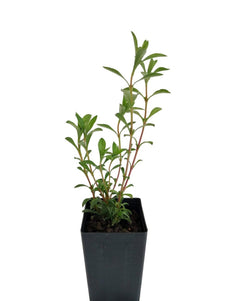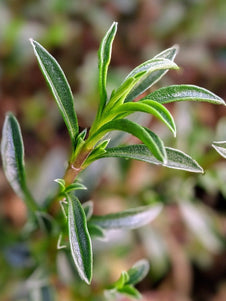







Savory - Winter Savory
Savory - Winter Savory

- In stock, ready to ship
- Inventory on the way

Usually available: All year
Life cycle: Perennial
Height: 40cm
Position: Full sun
Soil preference: Well drained
This is how we pack and send your Herb Plants to all states except TAS & WA
You will receive
- 1 Winter Savory Herb Plant in a 50 X 75mm tube - General growing instructions
All of our Herb Plants are grown organically with certified organic potting mixes and fertilizers
Botanical Name: Satureja montana
Winter savoury is an evergreen perennial that forms a low growing mound to 40 cm high and wide. The lilac or white flowers extend up above this in terminal spikes. The small summer flowers are 2 lipped and have purple spots on the lower lip. The dark green leaves are 1-2 cm long, opposite, lanceolate to ovate and wider at the tips. As a matter of comparison, Winter Savoury is a bushier plant than Summer Savoury although leaf cover is still quite sparse in both.
The botanical name is Satureja montana and the plant is native to the warm temperate regions of the Mediterranean, Europe and Russia. The Romans used this plant for cooking and introduced it to Britain during the time of Caesar. There are over 30 species of Savoury plant, including Summer Savoury, Lemon Savoury and Pink Savoury which are all in our catalogue.
It is likely that the genus name comes from the Turkish ‘sater’ and the Hebrew Za’atar. However, there are indications that the plant was named by the Roman Pliny, who may have created the name from the word ‘satyr’, which means half man and half goat. The English word ‘savoury’ is influenced by numerous derivations from the Latin Satureia/Satureja. In Middle Eastern countries there are many herbs which are used in spice blends that are given the name Za’atar, so they not regularly distinguished from each other. This can make it difficult to identify names and origins of some herbs from these regions.
Growing Conditions
Winter Savoury requires at least half a day of full sun and warm, dry conditions. This plant will perform best in poor to average rocky soils and has average to low water needs. A well-drained soil is essential and soil that is too rich will be detrimental to the plant. Winter Savoury becomes semi-dormant in winter and the branches loose leaves. In spring they will come back in to leaf and establish new growth. All the savoury plants are quite easy to grow and perform well as border plants or in cottage style gardens. They also grow well in containers. Propagation may be via cuttings in late spring, seed or by dividing the roots. Plants may become ‘worn out’ over time, so they may need to be replaced every few years.
Culinary Uses
Winter Savoury is an excellent culinary herb and may be used for any recipe that calls for savoury. It has a strong, spicy flavour and a strong herbaceous aroma. It may be used for white sauce, mushrooms, meat and legume dishes, white potato salads, in stuffing and vinegars, soups and herb breads. It is similar to Summer Savoury but is said to be have a more bitter taste. Although the herb has a strong flavour much of it is lost during prolonged cooking. Both plants have been in use for hundreds of years often found side by side in the herb garden.
Medicinal Uses
There are varying reports on the usefulness of Winter Savoury as a traditional medicine plant. Some say that it was not used at all, whereas other reports indicate that it has stronger action than Summer Savoury. Both are rich in essential oils including carvacrol and thymol, which is antiseptic. Medicinal use has included antiseptic, carminative, aromatic, digestive, expectorant, menstrual disorders, treatment of colic, gastroenteritis, nausea, cystitis, bronchial congestion and sore throats. Rubbing a sprig of leaves on insect bites and stings from bees and wasps is said to provide immediate pain relief. An ointment made from the oil is used to provide relief for arthritic pain. Harvest the leaves in summer when the plant is in flower and oil content is highest.
Other Uses
Winter and Summer savoury are thought to be good companion plants for beans and roses. The leaves may be dried and use in pot pourii.
All information provided on this website is for informational purposes only. Please seek professional advice before commencing any treatment.





